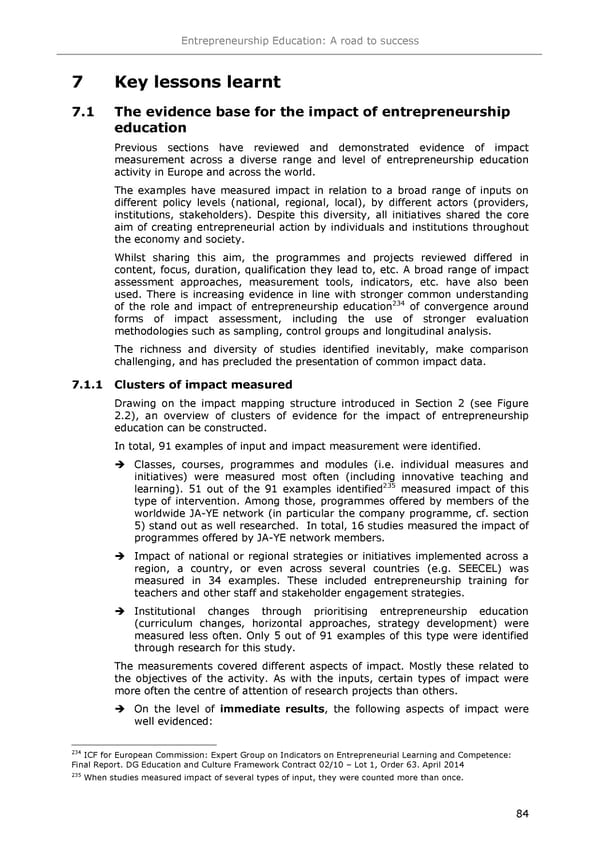Entrepreneurship Education: A road to success 7 Key lessons learnt 7.1 The evidence base for the impact of entrepreneurship education Previous sections have reviewed and demonstrated evidence of impact measurement across a diverse range and level of entrepreneurship education activity in Europe and across the world. The examples have measured impact in relation to a broad range of inputs on different policy levels (national, regional, local), by different actors (providers, institutions, stakeholders). Despite this diversity, all initiatives shared the core aim of creating entrepreneurial action by individuals and institutions throughout the economy and society. Whilst sharing this aim, the programmes and projects reviewed differed in content, focus, duration, qualification they lead to, etc. A broad range of impact assessment approaches, measurement tools, indicators, etc. have also been used. There is increasing evidence in line with stronger common understanding 234 of the role and impact of entrepreneurship education of convergence around forms of impact assessment, including the use of stronger evaluation methodologies such as sampling, control groups and longitudinal analysis. The richness and diversity of studies identified inevitably, make comparison challenging, and has precluded the presentation of common impact data. 7.1.1 Clusters of impact measured Drawing on the impact mapping structure introduced in Section 2 (see Figure 2.2), an overview of clusters of evidence for the impact of entrepreneurship education can be constructed. In total, 91 examples of input and impact measurement were identified. Classes, courses, programmes and modules (i.e. individual measures and initiatives) were measured most often (including innovative teaching and learning). 51 out of the 91 examples identified235 measured impact of this type of intervention. Among those, programmes offered by members of the worldwide JA-YE network (in particular the company programme, cf. section 5) stand out as well researched. In total, 16 studies measured the impact of programmes offered by JA-YE network members. Impact of national or regional strategies or initiatives implemented across a region, a country, or even across several countries (e.g. SEECEL) was measured in 34 examples. These included entrepreneurship training for teachers and other staff and stakeholder engagement strategies. Institutional changes through prioritising entrepreneurship education (curriculum changes, horizontal approaches, strategy development) were measured less often. Only 5 out of 91 examples of this type were identified through research for this study. The measurements covered different aspects of impact. Mostly these related to the objectives of the activity. As with the inputs, certain types of impact were more often the centre of attention of research projects than others. On the level of immediate results, the following aspects of impact were well evidenced: 234 ICF for European Commission: Expert Group on Indicators on Entrepreneurial Learning and Competence: Final Report. DG Education and Culture Framework Contract 02/10 3 Lot 1, Order 63. April 2014 235 When studies measured impact of several types of input, they were counted more than once. 84
 Entrepreneurship Education Page 87 Page 89
Entrepreneurship Education Page 87 Page 89